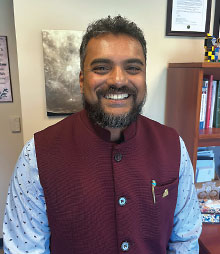Himanshu Agrawal, M.D., is the face of psychoanalysis that you may not have thought existed.
Agrawal, a candidate in the Minneapolis Psychoanalytic Institute (MPI), came to the United States in 2002 from India, where he had graduated from the Maulana Azad Medical College, New Delhi. He completed his psychiatry residency at Hennepin County Medical Center, where he was chief resident, and his child psychiatry fellowship at the University of Minnesota, where he was chief fellow.
Later, Agrawal moved with his wife, a cardiologist, to Milwaukee. In 2016, when he applied to be a psychoanalytic candidate at MPI, he had a request that was unheard of: He wanted to complete his training remotely using video.
The institute agreed, and Agrawal commenced to take his didactic courses and to undergo a training analysis remotely—with the stipulation that he make periodic trips to Minneapolis to meet with faculty and his training analyst in San Diego. (He had started psychotherapy with the analyst in Minneapolis progressing from twice-a-week psychotherapy on the couch to four-times-a-week analysis; in that time, he and the analyst relocated.) Agrawal has since completed both the didactics and training analysis; he is still engaged in his own analytic treatment, remotely supervised, of two patients he is seeing in his office four to five times a week.
“I will give my institute credit that they took this leap of faith even before COVID made them do it,” he said.
His unusual candidacy is emblematic of changes he said are brewing in psychoanalytic training and culture, a quiet revolt against the claustral atmosphere of training institutes and rigid adherence, over many decades, to the way things have always been done. Agrawal is chair of the American Psychoanalytic Association (APsA) Candidates’ Council, and he has vowed to be an activist and an advocate.
“I am a person of color and an immigrant, and I walked into a psychoanalytic world where, as in other areas of American life, there were micro- and macroaggressions happening everywhere,” he said. “The ‘othering’ is everywhere, but it is uniquely acute when it comes to African Americans and Hispanics for whom there is also a real socioeconomic disparity.”
About that socioeconomic disparity—Agrawal is adamant that the cost of psychoanalytic treatment and training is a threat to the profession. He is a member of the APsA Council on the Economics of Psychoanalysis and chair of a subcommittee on the cost of training.
“It’s really been the elephant in the room for ages,” he said. “I believe personally that the survival of this profession depends on making training and therapy a lot less costly, and I am worried we will go extinct if we don’t do something. In many parts of the country, the cost of your own training analysis is just not feasible for most people who might be interested in it.”
That’s borne out in the results of a survey that Agrawal conducted using the APsA listserv, which includes many psychotherapists who are not formally trained in psychoanalysis. “I wanted to know, What’s holding you back? The answer was clear—the cost of the training analysis, the cost of supervision, the cost of tuition at an institute, and the cost of money lost due to time off from regular practice.”
In addition, he wants to make institutional graduation requirements transparent and—ultimately—to standardize them. “There is a lot of ambiguity and opacity about what you need to do, how much money and time it will take to graduate,” he said. “There is a general sense of ‘don’t look at the man behind the screen; just jump in and it will be fine.’”
Agrawal said he believes APsA leadership today is committed to hearing candidates’ concerns. To psychiatrists who may feel estranged from the precepts, culture, and practice of psychoanalysis, Agrawal says: Come back.
“There is a movement afoot to evolve and reimagine psychoanalysis and psychoanalytic institutes. The current generation of candidates is vocal and sensitive—a group of independent thinkers who are as diverse as [the psychoanalytic candidate pool] has ever been. We are retaining the best of the past and bringing in the best of the present.” ■

